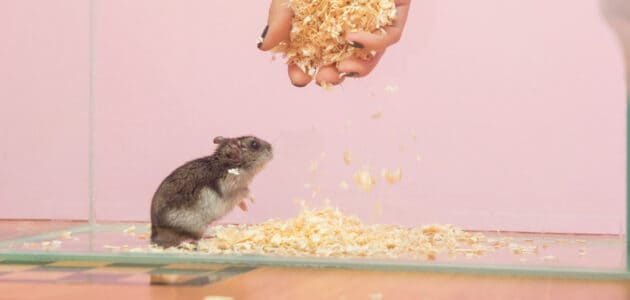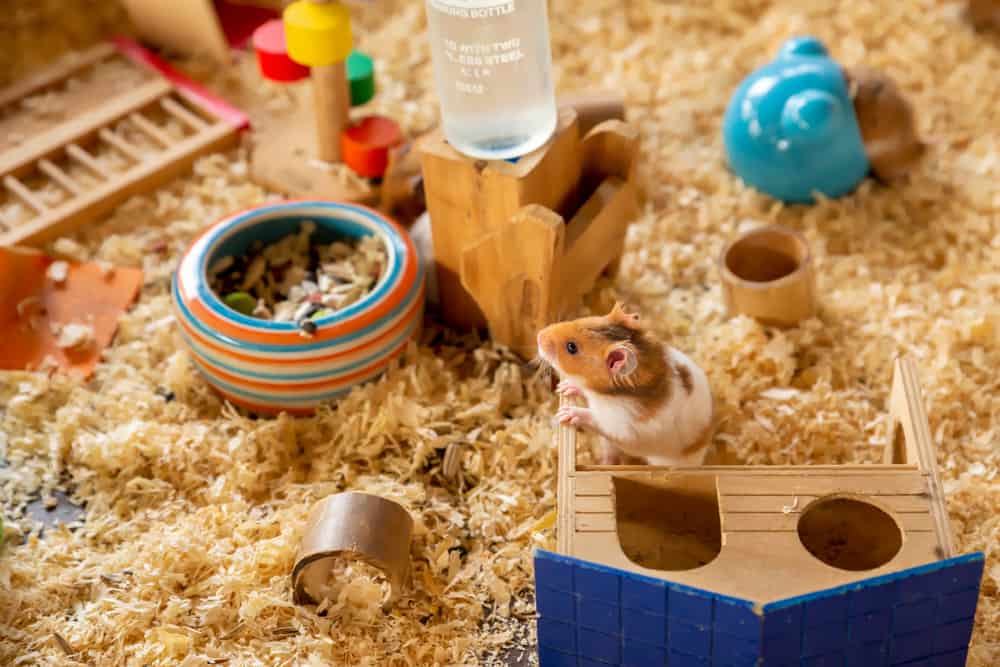How Do I Clean a Hamster Cage? How Often Should It Be Done?

Most hamsters are acquired by children who will think they’re cute and look at them all day on the first day and then nearly forget they exist. It’s then the parents’ job to take care of the little creature, but they probably didn’t want it in the first place—it was just a present. Due to this and all the misconceptions around caring for hamsters, the majority of them are neglected, have really bad lives, and probably die preventable deaths.
One of the best ways you can improve the life of a hamster is to give them a clean, suitable place to live. But they’re messy creatures, so you’ll need to put in a bit of work to keep everything shiny and sparkling—which is why we’re here to help with this guide to a well-kept hamster home.
Cleaning a Hamster Cage
There are multiple suitable options, such as bleach diluted in water and white vinegar diluted in water, however, both of these options need to be used carefully. You must rinse thoroughly because any traces left behind can be harmful to the hamster, not to mention the extremely strong scent.
The best to use is an anti-bacterial dish soap. It will be easier to rinse off, it kills bacteria and if there are any traces left accidentally, it won’t harm the hamster.
If the cage itself is small enough, the whole thing can be washed in the sink. Otherwise, you can spray the solution on and wipe it off, followed by a rinse with clean water. Dish soap can also be used to clean the bowls, wheel, and many other accessories.
Keeping Your Hamster Calm
Hamster balls are fun, but many things can happen to cause distress so I recommend only using the hamster ball when you can stay and supervise what goes on.
The best option is a hamster carrier! They are quite small but it’s good for short periods, provided you do the following:
- Keep it close to you while you clean, this way your hamster can see you and will probably be entertained observing what you’re doing.
- Fill the carrier with bedding. Not new bedding. Use some you take directly out of the cage before cleaning. Your hamster will recognize the scent and will be much calmer, leaving you to clean while he burrows and takes a little nap.
- Insert something familiar in there, like a toy, and sprinkle some food inside. That way your hamster will know it’s not the end of the world, it’s just a small vacation.
If you’re handling your hamster, offer it your hand to and from the cage, it trusts you so it knows everything is ok.
However, if you’re not handling your hamster yet, lay a mug in front of it and it will get curious and go inside. Gently tip the mug upwards making sure the hamster is turning upwards. This way you can carry it anywhere with no fear of dropping it or of it running away.
How Often Should I Clean My Hamster’s Cage?
How often you should clean will also depend on what kind of hamster you have.
Syrians tend to organize the enclosure in sections. They will have a designated bathroom, a designated sleeping spot, and even a special place where they leave all the food they dump from their cheeks.
With Syrians, spot cleaning is really easy! Just scoop out the bathroom area daily and replace that section of bedding. Nice and easy, right?
But if you happen to have another type of hamster, you need to be on top of your game every single day. They don’t have the same amazing organization system, they just do whatever they want whenever they want, without a worry in the world (you can probably tell how bitter I am).
With dwarf, Roborovski, Chinese, and Campbell’s hamsters, you need to try to find the places where the mess is more noticeable and scoop out those areas daily.
Something else you should do daily is clean the mouthpiece on the water bottle if you use one, while you’re at it you can check the flow on the bottle.
Apart from this daily ritual, everything else should be done in-depth once a week at least!
Everything should be washed, from bowls to wheels and the bedding should be completely replaced!
You will find that your hamster has hoarded quite a lot of food under the bedding, this is normal and you should ideally dispose of it when you dispose of the bedding. But you can try to save as much as you want.
After You Clean

After you clean your hamster’s cage from top to bottom, it’s time to put things back together!
First, the bedding. You should put as much as the cage allows, the deeper the better.
Then you can choose between using the same layout as before, or switching things around. Most animals will prefer for things to stay the same but hamsters enjoy exploring and it will make them happy to have something new to discover.
Finally, just let your hamster back in the cage and dispose of the bedding you previously put inside the carrier.
You must do all these things religiously. If you accidentally realize you should’ve done it 3 days ago, do it now! Don’t wait until the next due date.
Hamster Health and Happiness
Before we go, we should cover exactly what you’ll need to look for to be sure your hamster is thriving. In terms of their physical health, hamsters need their skin, fur, teeth, and nails checked regularly. Here’s what to look out for:
Skin
Hamsters retain natural oils on their skin so naturally when it becomes dry, it becomes a big problem. You can help them by rubbing some coconut oil on their skin. Do not use too much! A dipped tip of your finger should do the trick.
Fur
You should keep an eye out in case something gets stuck on their fur or they get wet. More importantly, if their fur looks greasy or if you can see bald spots there may be a more serious underlying condition. Here are the five most common reasons for fur loss in hamsters.
Teeth: This is the most important thing to observe. Hamster’s teeth never stop growing and they may have quite a few problems associated with them. If you provide chewing toys and their diet is right they should be ok, but just in case, you should find out more about how to keep your hamster’s teeth healthy.
Nails
You probably don’t have to worry about this at all. Those little furballs are pretty fantastic when it comes to taking care of themselves, and that includes manicures! They can keep their nails short without help.
However, if you notice they start curling you do need to take care of it. I don’t recommend doing it yourself, as their nails are significantly short and fragile, but if you wish to attempt and you’re confident, your hamster trusts you and you know it well, then here’s how you should do it.
Building the Perfect Hamster Home

Not only is it important to keep your hamster’s home clean, but a happy hamster will also want a space filled with accessories to keep them occupied and in tip-top shape.
Wheel
The ideal wheel should vary in size depending on the kind of hamster you have. Syrians will need a wheel with a diameter from 8 to 12 inches, while a dwarf will be perfectly safe with a 6 inch wheel.
Did I say safe? Indeed. If the wheel is too small for your hamster it can cause problems on their spine.
One more thing, DO NOT get wired wheels, please. Their feet can get stuck, they can hurt their legs and they will get structural issues on their feet over time.
Bedding
Hamsters are natural burrowers so bedding is one of the most important factors to consider. I recommend recycled paper or wood shavings.
Be careful with the wood shavings, as they need to be aspen. You usually find pine and cedar in most pet shops but it is not suitable as these can break into tiny, sharp pieces. When ingested, this will hurt your hamster internally.
Also, pay attention to the smell of the bedding! Some have an almost chemical smell to them and that isn’t good for them, or you! The smell is really strong, trust me.
Though it is on the market, DO NOT use sand as bedding, as it’s not a good choice for the entire foor of the cage—instead, concentrate it into a sand tub.
Water Bottle or Bowl
If you have a wired cage, the hamster bottles sold everywhere are a good option. Just make sure to check how strong the flow is and if it leaks. Bad quality bottles can make it difficult for your hamster to have a drink.
Another option is a food bowl! If you do take this option keep in mind that you will be cleaning and refilling the bowl several times a day because your hamster will probably think it’s funny to put bedding inside the bowl!
This being said, the option is not so practical but it’s a lot more beneficial for their health as they don’t have to bend unnaturally to drink like they do with the bottle. You also need to keep the water shallow because as you know, they shouldn’t get wet.
Food Bowl
No special requirements here! Choose any bowl you want and it’ll be one of their favorite places. You can also put food inside little toys or boxes, be creative! Hamsters enjoy mental challenges.
Don’t forget to fill it with a high-quality hamster food, too!
Chew Toys
Like I said, chewing toys are essential to keep your hamster’s teeth healthy. These don’t need to be fancy toys at all! Little wooden blocks and shapes will work just fine! Remember to replace them if the hamster starts destroying them.
Recreational Toys
Again, go wild! Hamsters enjoy mental challenges so keep adding new things regularly. Puzzle and exercise toys are amazing and not expensive, but even a toilet paper tube will keep them entertained for a while.
Sand Tub
You can use any style sand tub want, just make sure it has some depth and it’s fairly wide.
The sand will need to be replaced often too, especially if your hamster likes to use it as a toilet! You can get reptile sand as long as it doesn’t have calcium or dyes, it usually comes in larger quantities than hamster bathing sand, and the result is the same.
Final Thoughts
Hamsters should be kept in sanitized conditions to live a happy and healthy life, just like any other pet, or even people. Make sure to be a responsible owner and think about your animal’s wellbeing first and foremost.



